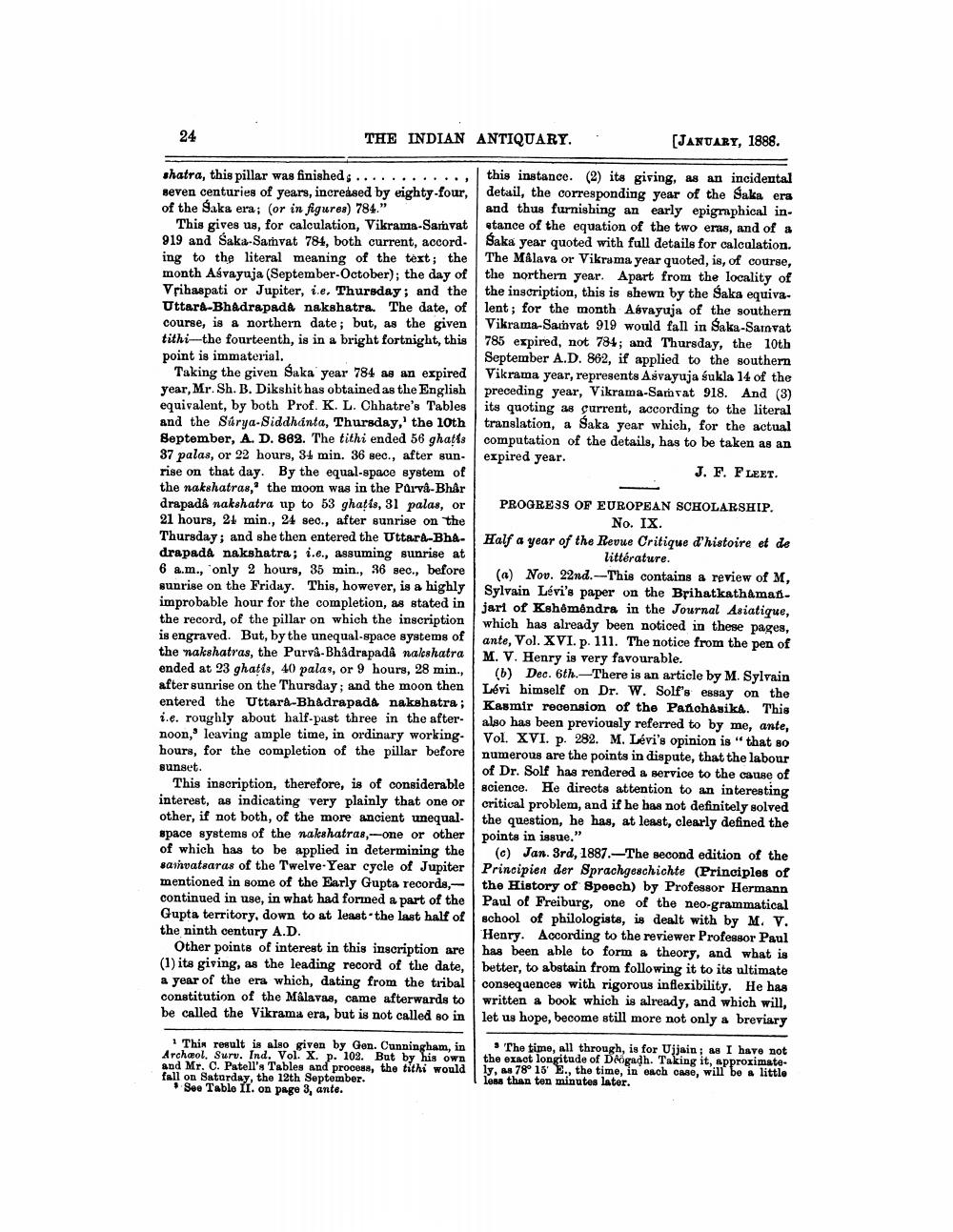________________
24
THE INDIAN ANTIQUARY. .
(JANUARY, 1888.
shatra, this pillar was finished .....
this instance. (2) its giring, as an incidental seven centuries of years, increased by eighty-four, detail, the corresponding year of the Saka era of the Saka era; (or in figures) 784."
and thus furnishing an early epigraphical in. This gives us, for calculation, Vikrama-Sarvat etance of the equation of the two eras, and of a 919 and Saka-Samvat 784, both current, accord. Saka year quoted with full details for calculation. ing to the literal meaning of the text; the The Malava or Vikrama year quoted, is, of course, month Asvayuja (September October); the day of the northern year. Apart from the locality of Vrihaspati or Jupiter, i.e. Thursday; and the the inscription, this is shewn by the Saka equivaUttara-Bhadrapada nakshatra. The date, of lent; for the month Asvayuja of the southern course, is a northern date; but, as the given Vikrama-Sauvat 919 would fall in Saka-Samvat tithi--the fourteenth, is in a bright fortnight, this 785 expired, not 784; and Thursday, the 10th point is immaterial.
September A.D. 862, if applied to the southern Taking the given Saka year 784 as an expired Vikrama year, represents Asvayuja sukla 14 of the year, Mr. Sh. B. Dikshit has obtained as the English preceding year. Vikrama-Sarhvat 918. And 121 equivalent, by both Prof. K. L. Chhatre's Tables its quoting as current, according to the literal and the Súrya-Siddhanta, Thursday, the loth translation, a Saka year which, for the actual September, A. D. 862. The tithi ended 56 ghatis computation of the details, has to be taken as an 37 palas, or 22 hours, 34 min. 36 sec., after sun- expired year. rise on that day. By the equal-space system of
J. F. FLEET. the nakshatras," the moon was in the Parva-Bhar drapada nakshatra up to 53 ghatis, 31 palas, or PROGRESS OF EUROPEAN SCHOLARSHIP. 21 hours, 24 min., 24 sec., after sunrise on the
No. IX. Thursday; and she then entered the Uttara-Bh. Half a year of the Revue Critique d'histoire et de drapada nakshatra; i.e., assuming sunrise at
littérature. 6 a.m., only 2 hours, 35 min., 36 sec., before
(a) Nov. 22nd.-This contains & review of M, sunrise on the Friday. This, however, is a highly Sylvain Lévi's paper on the Brihatkathamani. improbable hour for the completion, as stated in jart of Kshêmêndra in the Journal Asiatique, the record, of the pillar on which the inscription which has already been noticed in these pages, is engraved. But, by the unequal-space systems of ante, Vol. XVI. p. 111. The notice from the pen of the nakshatras, the Parva-Bhidrapada nakshatra M. V. Henry is very favourable. ended at 23 ghatis, 40 palas, or 9 hours, 28 min.,
(6) Dec. 6th. There is an article by M. Sylvain after sunrise on the Thursday, and the moon then Lévi himself on Dr. W. Solf's essay on the entered the Uttard-Bhadrapada nakshatra ; Kasmir recension of the Panchasika. This i.e. roughly about half past three in the after
also has been previously referred to by me, ante, noon, leaving ample time, in ordinary working. Vol. XVI. p. 282. M. Lévi's opinion is that so hours, for the completion of the pillar before numerous are the points in dispute, that the labour sunset
of Dr. Solf has rendered a service to the cause of This inscription, therefore, is of considerable science. He directs attention to an interesting interest, as indicating very plainly that one or critical problem, and if he has not definitely solved other, if not both, of the more ancient unequal. the question, he has, at least, clearly defined the space systems of the nakshatras,one or other points in issue." of which has to be applied in determining the (c) Jan. 3rd, 1887.-The second edition of the samvatsaras of the Twelve-Year cycle of Jupiter Principien der Sprachgeschichte (Principles of mentioned in some of the Early Gupta records, the History of Speech) by Professor Hermann continued in use, in what had forined a part of the Paul of Freiburg, one of the neo-grammatical Gupta territory, down to at least - the last half of school of philologists, is dealt with by M. V. the ninth century A.D.
Henry. According to the reviewer Professor Paul Other points of interest in this inscription are has been able to form a theory, and what is (1) its giving, as the leading record of the date, better, to abstain from following it to its ultimate a year of the era which, dating from the tribal consequences with rigorous inflexibility. He has constitution of the Malavas, came afterwards to written a book which is already, and which will, be called the Vikrama era, but is not called so in let us hope, become still more not only a breviary
This result is also given by Gen. Cunningham, in Archæol. Suru. Ind. Vol. X. p. 103. But by his own and Mr. C. Patell's Tables and process, the tithi would fall on Saturday, the 12th September.
* See Table II. on page 3, ante.
The time, all through, is for Ujjain : as I have not the exact longitude of Déogadh. Taking it, approximately, as 78° 15' E., the time, in each case, will be a little less than ten minutes later.




